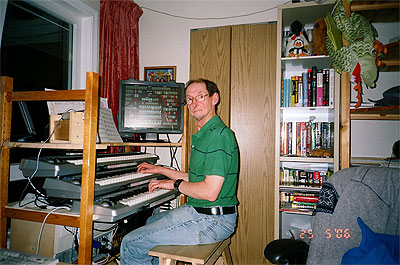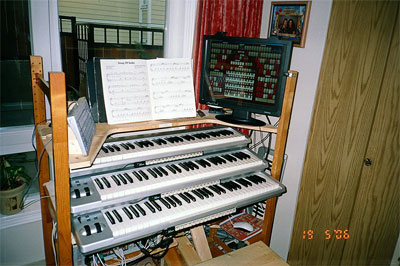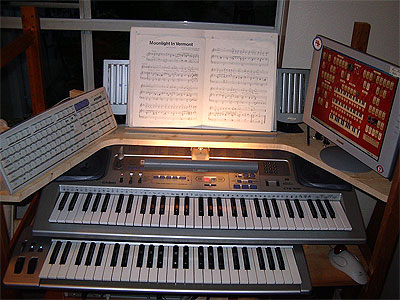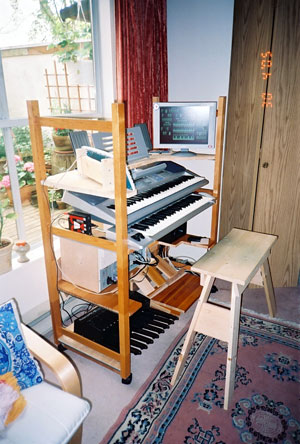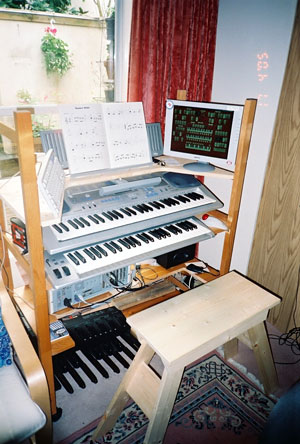
|
|
|
Russ Ashworth is a stickler for detail when it comes to his Mighty MidiTzer. He obtained a blueprint of the AGO specification that shows in the tiniest detail where things are supposed to be when seated at the console of a real TPO. He then proceeded to construct a special workshelf for his equipment that placed it inside the dimensions of the actual instrument, and came up with an organ that is just right for getting the feel of a live performance. He is a member of the ATOS, the Walnut Hill VTPO and Theatre Organ SoundFonts groups on Yahoo! and also holds the office of Public Relations and Education in the Walnut Hill Organ Club. Russ Ashworth is featured in the Walnut Hill Featured Artists section. To hear what he does with the Little VTPO That Could, click here. His logic was to recreate the placement of pipe organ devices at the console so that when he got the chance to play the Mighty WurliTzer, he would know instinctively where to put his hands and feet without having to adjust from his practice instrument. I think he has succeeded.
The Latest Version Of Russ's Mighty MidiTzerThis is version 4 of Russ Ashworth's Mighty Miditzer featuring the 3/19 Style 260 Special edition. It has a 19-inch LCD monitor with touch screen overlay, three M-Audio Keystation 61-ES manuals, each having an X-key stick, and a 13-note Roland PK-5 pedalboard with two Swell and crescendo pedals using control circuittry from Sound Research activated by home-made pedals. Russ tells us more and we quote him below in blue text. In May 2006 with the testing of the upcoming 3 Manual MidiTzer 260SP, I decided to add another keyboard. My original idea was to somehow balance the third one above the controls of the Casio as I didn't use any of them but just used the keyboard part. I then found that the M-Audio Keystation 61-note MIDI controllers were on special and selling at about half the price that I was expecting. So, I got tow of them and gave the Casio to my Daughter-in-Law. Then I decided to go the whole way and get a third one while the sale was on to replace the original 49-note unit. Because there aren't any controls above the keys, these units can be stacked almost like real organ keyboards. I also needed to replace the CRT monitor on my regular computer so I moved the organ LCD monitor back to where I stole it from and bought a new monitor for the organ computer. After some experimenting, I had decided that it would need to be 19 inches diagonally to make the the controls of the MidiTzer 260SP big enough to be operated with a touch screen overlay, which I also have. I have small hands, so if your hands are normal or bigger, then you may want to go for a 21-inch screen size. The touch screen overlay is made by Keytec. I also fitted Xkeys Keysticks below each of the three keyboards to act as combination pistons. These piggyback together into the PS/2 keyboard port and are programmed by remembering computer keyboard keystrokes.
Russ Ashworth's Mighty MidiTzer: First VersionRuss Ashworth is constantly seeking ways to make his virtual theatre pipe organ setup as close to the real thing as possible. Below the pictures to follow, we use his own words to describe the evolution of his Mighty MidiTzer vrtual TPO setup, now in its third version... 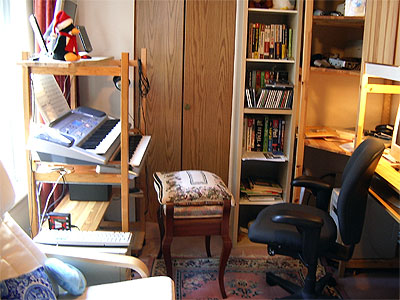 This is Russ Ashworth's workspace, showing the first version of his Mighty MidiTzer. This is the first version of my Mighty MidiTzer setup. This gives you an idea of how little space I have. The piano (organ) stool is back to back with my computer chair, which is swiveled in this view. The console frame is made from an IKEA Ivar shelving system of standard width but, in the first version, it wasn't wide enough. The organ computer is on the floor with the Windows keyboard on top. 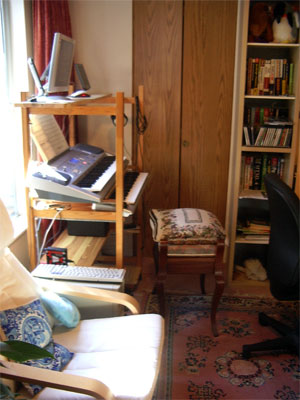
A closer view of the first version of Russ Ashworth's Virtual Theatre Pipe Organ Setup. This view shows the LCD monitor I borrowed from my main Linux computer on a temporary and very awkward to use top shelf. Also up there is the mouse and speakers. The bass speaker is the black box on the lower shelf. 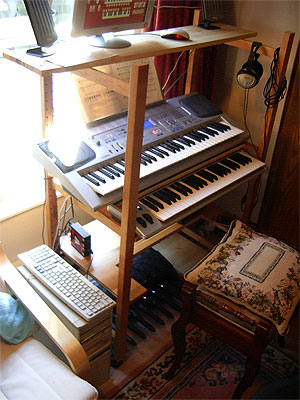
Looking down at the keydesk of Russ Ashworth's Virtual Theatre Pipe Organ Setup, first version. As you can see in this view of the first version, the shelving was too narrow for the Casio keyboard and the pedals were too far to the right. In the second version, I widened the shelving one octave and moved the computer into a more compact case, putting it on a shelf underneath the keyboards. This gave me the extra nine inches of floor space that I needed. The three lights on the floor are LED's on the Roland pedal board. 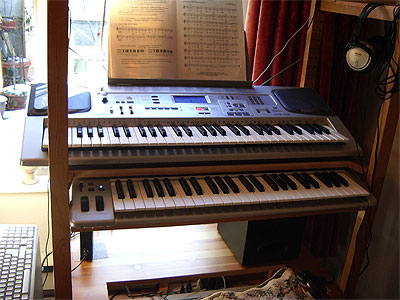
A close-up of the first version of Russ Ashworth's Virtual Theatre Pipe Organ setup. This gives you a good idea how much too narrow the frame was. Increasing it one octave allowed me to move the lower keyboard to the left so that it is now lined up the bottom octaves. I moved the pedals a couple of inches to the left in the second version. The big problem was, I had to do all this whilst still being able to play it. You see, I don't want to turn it off, it just sounds so good.
Russ Ashworth's Mighty MidiTzer: Second VersionRuss Ashworth was not comfortable with the first incarnation of his Mighty MidiTzer, so he rebuilt and revised the shelving to make it more ergonomic and easier to play. Below are some pictures of the second version of his virtual TPO setup. We quote him below: 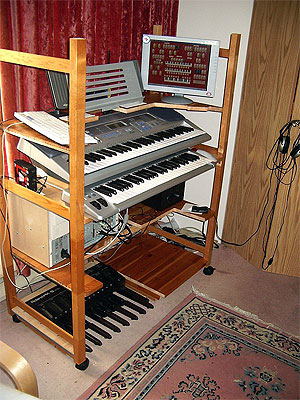
Here, we see Russ Ashworth's Mighty MidiTzer, second version. Here is a picture of the widened "console" with the new temporary top shelf. You can see how much wider it now is by the gap under the music stand. Note that the console is developing a pleasing horseshoe shape. :) 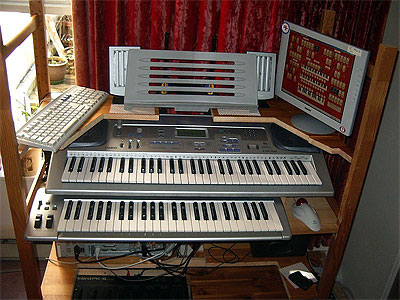
A close-up of the console of Russ Ashworth's Mighty MidiTzer after the second revision. In the second version, I widened the "console" and put the computer in a more central position. I also added two angled shelves on either side above the Casio keyboard, placing the computer keyboard on the left and the monitor on the right. One day the monitor will be a touch screen device. Meanwhile, I have a small trackball located to the right of the lower manual. 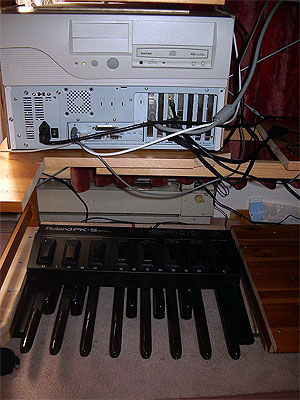 Russ Ashworth's Mighty MidiTzer chopped and channelled WinTel computer and pedalboard. Here is a picture of the computer, which is in a desktop computer case cut in half side to side and the front and back halves stacked one above the other. This virtual hot rod Wurlitzer has a chopped and channeled computer running it. :)
Russ Ashworth's Mighty MidiTzer: Third Version
This is the keydesk of Russ Ashworth's Mighty MidiTzer. He describes it below: The setup I have now is pure MidiTzer, and not much bigger than a home keyboard. I can play it either with headphones or a tree piece loudspeaker system. It has a MIDI keyboard, the old MIDI pedal board and the MIDI output from a Casio home keyboard (which very occasionally adds a piano voice.) What I now have is a two manual ten rank virtual 2/10 Mighty WurliTzer Style 216 Theatre Pipe Organ in my home that I am frantically learning how to get the best from. I am learning how to register and play a theatre organ, and having a blast doing it. I have a lot of lost time to catch up on. If I ever get the chance to play a real TPO, or a Conn or Rodgers, or an Allen or Walker digital instrument, I will know how to build up those sounds, because my MidiTzer has all of these voices and more.
The MidiTzer has more stops on the pedals than my Yamaha had on the entire organ! It is wonderful. 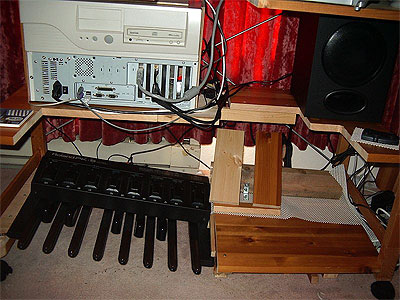 Looking at the chopped and channelled computer above the pedalboard assembly. Here, we can see the custom chopped and channelled computer mounted above the bass pedal clavier assembly. The swell shoe assembly is slightly above and to the right of the bass pedals. Russ explains below: I have a MIDI swell controller on the way from Vern which will go on the shelf to the right of the pedals. Also I have raised the left hand side of the pedals about a couple of inches and angled it in like the lower end of a radial pedal board.
Getting inducted to the Wall of Fame is easy!Who doesn't want recognition for their efforts with the Mighty MidiTzer? Now, you can get noticed on the Walnut Hill Wall of Fame! Folks will see your pictures and be able to go directly to your site by clicking on them. We hope to see many more inductees here in the days ahead as folks step out with their Mighty MidiTzers. So... Dust off those cameras and get snappin'. Also, if you have recordings or any other content you want featured, we can put those here as well. Email The Bone Doctor to find out how you can be among the ranks of those who are pioneering this Mighty Virtual Theatre Pipe Organ. Join TOSF and Walnut Hill VTPO and make your intentions known to all the folks in VTPO land. We are always glad to recognize those who make the TPO kingdom a better place! |
